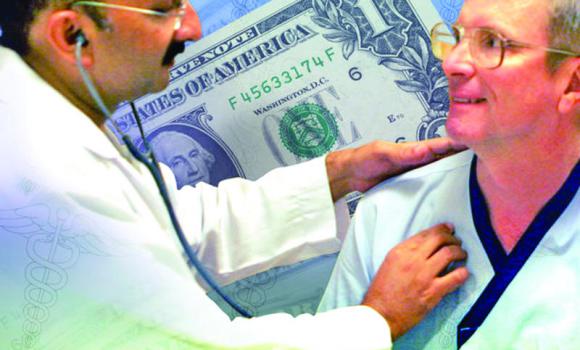From cutting edge surgeries to routine ones, from modern treatment to traditional therapies like ayurveda, unani, siddha and yoga, the Indian health care system offers all at a much lesser price than what it would cost in many other countries offering such services.
Medical tourism is a growing sector in India and the country has emerged as a leading health care destination with thousands of ‘medical tourists’ availing the services of its hospitals having the most skilled doctors in the world and modern medical equipment.
India’s medical tourism sector is expected to experience an annual growth rate of 30 percent, making it a $2 billion industry by 2015. As medical treatment costs in the developed world balloon — with the United States leading the way — increasing number of Westerners are finding the prospect of international travel for medical care very appealing.
According to the Confederation of Indian Industry (CII) 150,000 medical tourists came to India in 2005, based on feedback from the organization’s member hospitals. The number grew to 200,000 by 2008. A separate study by ASSOCHAM reported that the year 2011 saw 850,000 medical tourists in India and projected that by 2015 this number would rise to 3,200,000.
India’s choice as a preferred destination for medical tourism has been helped by the government offering the special ‘M’ visa to medical tourists — the visas are valid for a year and are issued for companions too.
The Indian government is taking steps to address infrastructure issues to help the country’s growth in medical tourism.
The government has removed restrictions on tourist visas that require a two-month gap between consecutive visits for people from Gulf countries which is likely to boost medical tourism.
A visa-on-arrival scheme for tourists from select countries has been instituted that allows foreign nationals to stay in India for 30 days for medical reasons.
Most estimates claim treatment costs in India start at around a tenth
of the price of comparable treatment in America or Britain.
The most popular treatments sought in India by medical tourists are alternative medicine, bone-marrow transplant, cardiac bypass, eye surgery and hip replacement.
Chennai has been termed India’s health capital. Multi- and super-specialty hospitals across the city bring in an estimated 150 international patients every day.
Chennai attracts about 45 percent of health tourists from abroad arriving in the country and 30 to 40 percent of domestic health tourists. Factors behind the tourists inflow in the city include low costs, little to no waiting period, and facilities offered at the specialty hospitals in the city.
India’s efforts to promote medical tourism took off in late 2002, when the CII prepared a study on the country’s medical tourism sector, which outlined immense potential for the sector.
The following year, then finance minister Jaswant Singh urged measures such as improvement in airport infrastructure to ensure smooth arrival and departure of medical tourists.
There is almost no waiting time for surgeries in India, a boon for patients from countries such as the US and Britain where the queues are long. Though the maximum medical tourists to India are from the US, Africa is catching up fast. In 2011, for instance, more than 30,000 patients came from Kenya and about 10,000 from Tanzania. Cost is a major factor as stem cell transplant, a process by which new cells are introduced into damaged tissue in order to treat diseases or injuries, has shown promise in treating various kinds of diseases, including some cancers.
Outside India, a stem cell transplant could cost up to Rs1 crore (approx $223,000), depending on the type of procedure, and the patient is asked to deposit the full amount before the procedure. In India the same procedure in a private hospital would cost between Rs10-Rs20 lakh (approx $18,500 to $37,000) in private hospitals. Uniquely Indian treatments like ayurveda and yoga for rejuvenation and wellness are helping states like the southern Indian state of Kerala rise to fame.
According to a CII-McKinsey report, medical tourism industry in Kerala is expected to be worth $4 billion by 2017. There are other treatments too — a comprehensive rehab policy for ‘narcotics-induced psychotics’. A recent group in New Delhi included people from the US, Canada, Oman as well as from Southeast Asia.
Though Thailand is at present dominating the medical tourism market in Asia followed by Singapore, India’s share in medical tourism is expected to grow substantially.
Hospitals are cashing in on the trend sprucing up facilities available on their premises.
A full-fledged movie lounge, a spa, a gym and fast food outlets are just some of the facilities on offer for patients and their attendants at corporate hospitals in Indian cities.
The Fortis hospitals, for instance, has a huge shopping arcade, a bakery, a spa, gym, a host of fast food outlets and also a 36-seater movie theater to screen free film shows for the patients and their attendants.
These days when it seems like every country in the world promotes itself as a haven for medical tourism, the reality is that in most cases they offer sub-standard facilities and limited skills, but India has tens of thousands of skilled physicians and nurses.
Over the last two decades, the economic boom in India has led to the building of medical facilities and infrastructure that rival the very best that western medical care has to offer. Many of the physicians that practice in these hospitals and clinics have returned (to India) from the US and Europe, leaving behind successful practices.
While some small countries may be viable as alternatives for minor surgical procedures, India is a mainstream option that offers a comprehensive solution for any and all medical needs, and does this with the highest levels of service, facilities, and professional skills.
A complex transplant or bypass procedure can be achieved for a tiny fraction of the cost for the same procedure in the United States.
source: http://www.arabnews.com / Arab News / Home / Riyadh : Rashid Hassan / Thursday, August 15th, 2013


